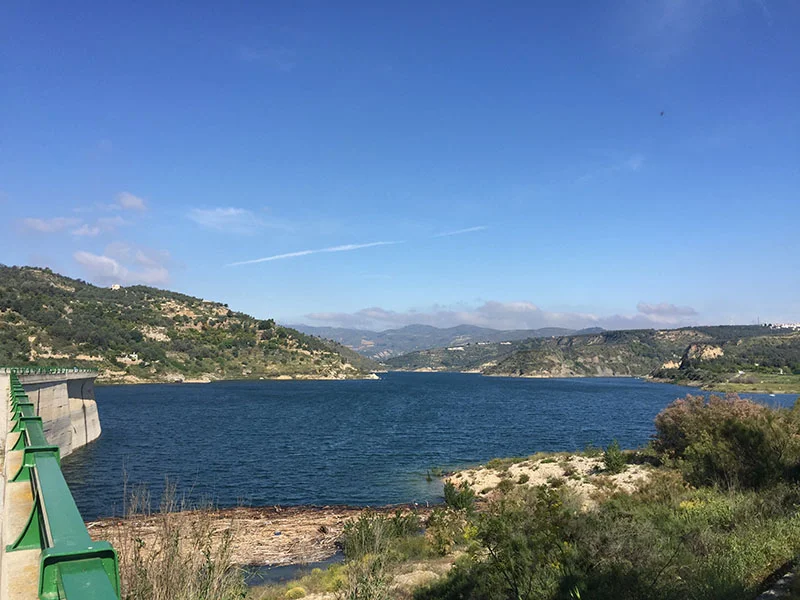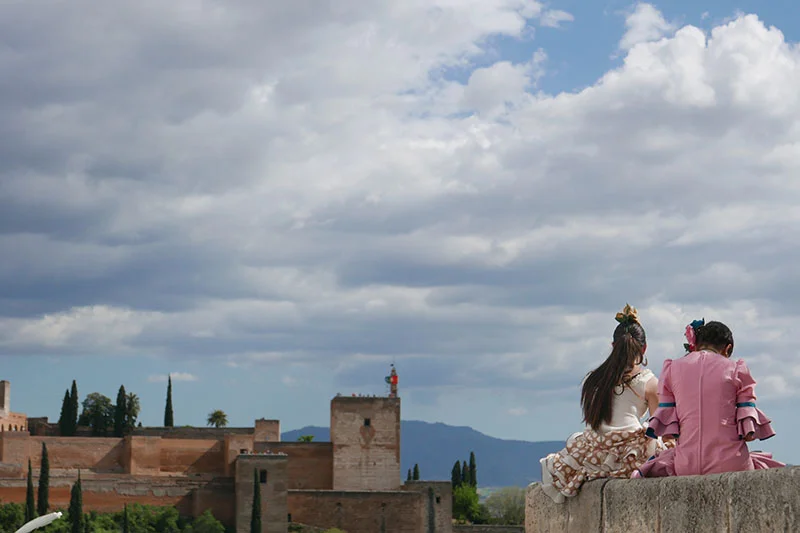Ne'er cast a clout....
My Grandmother always had a wise word to say about every situation, and these sayings often get dragged out at the most appropriate times, much to Andrew’s evident consternation. However, this year, in Spain, casting clothing before the Hawthorn Blossom appears may well have been imprudent as winter has dragged its heels well into the slot where Spring should have been.
It has been unusually wet here this first part of the year. As well as the cold winter, which is to be expected, the rains came in March and didn’t really stop for that entire month. Storms and unsettled weather continued into April and here we are in May, and we are not really settled into any climatic stability. There is no disputing that we needed the rain, and the reservoirs hereabouts are almost completely replenished, and the display of wild flowers across Granada Province (and, no doubt, elsewhere) has been spectacular. However, we are looking forward to the summer now.
As usual, we have been busy, and we are just getting ready for a trip to the UK for a wedding and a catch-up with family. We then return to see the builders start work on our new home!
So, what has happened over the past few weeks? There is a definite sense of anticipation as Spring arrives in Andalucia, despite the unsettled weather, and local residents get ready for ferías and festivals, and Granada starts to deck out its streets in summer garb - awnings appear across the main commercial streets to shade promenaders from the midday sun. That said, they probably do an equally good job of protecting the unsuspecting from the prevailing short, sharp rain showers.
It has been a testing time of late, with one thing and another. My hugely loved classical music radio programme has come to an end. The radio station that broadcast this programme has had its funding removed and so all the special interest programmes, of which mine was one, have been axed and the station itself will close the curtains in October. A very sad blow, as this programme meant an enormous amount to me over the past 6 years. Looking forward with optimism, there is hope that the content will be made available to another funder, so there may be life in the old dog yet…..
Andrew has had an equally frustrating time gaining traction with his increasingly fabulous portfolio of design work. These things take time and we both have to keep reassuring each other to persevere, but on some days, when we have been cooped up in a chilly house, with the rain lashing down outside, it has been hard to see beyond the thundery clouds overhead. On those days when we have seen clear skies, we have nipped down to the beach, cast off the shackles imposed by computers and deadlines and reminded ourselves just how lucky we are to be living here.
As one door closes….was that said by my Grandmother or Maria von Trapp in the ‘Sound of Music’? As one door closed another did open, and I am now taking visitors to Granada on tours around some of the Tapas hotspots, and what fun this is proving to be! In conjunction, Andrew and I have been working on another little project that is due to go live within the next week or so (no pressure there!), and something that we have been aiming to do since we arrived here in Spain. The creative spirit is alive and kicking!
A few weeks ago, to add another blow, I received the devastating news that my brother Kim has been diagnosed with a rare, aggressive and incurable form of cancer: mesothelioma. Evidently, this is the result of exposure to asbestos when he was aged 16, so some 48 years ago. I am incapable of putting feelings into suitable words. Suffice to say, I cannot wait for his current treatment to run its course and for him and his family to come and relax in our own beautiful corner of the world.
Anyway….on to more jolly happenings.
Fiesta Dia de la Cruz, Granada
May started off with a bang, as there was a public holiday on 1st May and then on 3rd May Granada celebrated the Fiesta Die de la Cruz. Santa Cruz is celebrated across Spain and attracts thousands of visitors every year.
In Granada, their celebrations date from 1625 when locals in the San Lazaro area of the city decorated a cross in one of their squares, and marked the occasion with singing and dancing. Over the past 400 years, the festival has grown and many of the city’s squares have crosses adorned with flowers and dressed with shawls, ceramics and copper vessels. Beneath each cross, you will find an apple pierced by a pair of scissors, referred to as the ‘pero’, or ‘but’… The Spanish are always great at giving advice, and not always in the most constructive way, and this symbol is a warning to any of the locals that they are not to criticise the decoration of the cross - in other words, if you choose to start your observations with “Well, it’s quite a nice cross, but….” then you risk having your tongue cut out! Let that be a warning!
A few years ago, there used to be beer stalls in many of the squares where crosses could be seen, but for some reason drinking got out of hand, which is very unusual for Granada. One of things we both notice and admire is that there is generally a distinct lack of binge drinking to the point of inebriation. The beer stalls have been removed but the drunkenness seems to prevail. We took a wander through the Albayzin in the afternoon of the Dia de la Cruz and on almost every street corner there were gatherings of university-aged adults sitting with bottles of alcohol bought from the supermarkets, and their sole aim was to get drunk.
Everyone dresses up for el Dia de la Cruz
I had to teach that evening, and we were meeting friends in the city to enjoy the fiesta, as it is an occasion where the great and the good do don their smartest gear; the ladies sport their finest Flamenco dresses. After school, at around 21:30, I caught a taxi into the centre of the city, and there were scenes I had not seen here before. Police had cordoned off streets, and arrests had been made, and there were drunk people in many of the side streets in the historic centre. We tried to work out why this seemed to be such a popular festival for university-aged adults, and can only assume that the date falls somewhere in between the end of the academic year and the start of exams, so it is as good a time as any to let collective hair down. It would be a shame if this festival did get a less-than-savoury reputation, as the spectacle of the adorned crosses, the dancing and the clothes is a great start to earl summer.
Romeria Cerro de le Virgen, Restabal
Much less of a drink-fest and a week or so after el Dia de la Cruz, our neighbouring village of Restábal held the annual Romeria Virgen del Cerro, when the Virgen de Fátima is brought out of her Ermita and processed down the hillside into the village below. We had seen posters for this event and then we discovered that new friends of ours from Moclin were planning on attending as they had been invited to lunch by the Mayor of El Valle; even more of a reason for us to make an appearance.
We’d not been to this fiesta before, but we assumed that the centre of the village would be vibrating to music and dance, and that it would be easy to get to the heart of the party. The clue to the fiesta's actual whereabouts is in the name of the fiesta - cerro, or hill. We walked from Saleres to Restábal, which is a lovely 30 minutes’ stroll through orange groves, usually rewarded by a drink in one of the village’s bars. On this day, however, we arrived to find the village all but deserted; no sound of music or revelry, and we wandered through the streets trying to find some signs of life. A Spanish family arrived at the same time as us, in a couple of cars, and we followed each other around hoping for visible signs of a party. Eventually, we bumped into some villagers and asked for directions to be told that the Romeria was at the Ermita above the village on the hillside.
Well, we have walked up this hill before on one of our local hikes, and it is a killer! From the village centre it is a steep climb to get to the Ermita, and having walked from Saleres and in dire need of a cold drink the prospect of a steep walk was not an attractive one. However, as we had no immediate desire to walk home, dry, we had little option but to tackle the hill.
Romeria Cerro de le Virgen
Village festivals are great fun. They are absolutely central to village life, and they bring together friends, families, young and old in a spirit of goodwill and warmth. For foreign visitors to these villages, we can understand that these village gatherings might be daunting, buzzing as they are with close groups of Spanish people who have little or no command of English; indeed, why would they need such a command? But to venture into these very villagey events is to immerse yourself fully in the culture of an Andalucian way of life, and the locals could not be more welcoming of new visitors. When we managed to clamber up the hill, it seemed that the entire village, and assorted friends and relatives, had settled around tables shaded by trees or by the long bar. A brass band played, and a couple of beautifully turned-out horses stamped their presence on the afternoon. As the brass band approached each table, villagers took hold of a partner and danced a gentle Sevillana; young girls sashayed around in their frilled flamenco dresses. Everything is hugely good-natured, and why would it not be as friends and family gather in such idyllic surroundings? In the crowd, we only noticed one other expat, despite their being such a large percentage of non-Spanish people who have homes in this area.
At the bar, we bought a token for the paella lunch and a ‘bottomless’ ceramic vessel - refill with beer or tinto de verano whenever we wished! The paella portion was huge, the weather was fine and the atmosphere extremely convivial. Our friends, Alessandra and Manuel, came and said hello and urged us to join them at the Mayor’s table where we met a few of the villagers proud to boast that they were neighbours of the author Ian Gibson during the time when he lived in the village. His house is now owned by the creator of the Teletubbies, we understand, so all a slightly surreal conversation to be had in Spanish over jamón, queso and the hugest of beef tomatoes.
With our far-from-fluent Spanish, we managed to chat to the great and the good of our neighbouring village and cement relations with our local Mayor who has a keen interest in Andrew’s designs and the blog post he wrote recounting his tortuous run through the valley to mark La Carrera de Campestre de la Naranja. It doesn’t take much to feel a sense of belonging in rural Andalucia, and the locals love to make you feel welcome, share their stories and their food.
So, May comes to an end and June has now started with a little more promise. Hopefully, now we can start to put away wintery clothes and look forward to a beautiful summer.












